|
Area of Segment = ½ × (θ - sin θ) × r2 (when θ is in radians)
Area of Segment = ½ × ( (θ × π/180) - sin θ) × r2 (when θ is in degrees)
Area of a Circle by Cutting into Sectors
Here is a way to find the formula for the area of a circle:

Cut a circle into equal sectors (12 in this example)
Divide just one of the sectors into two equal parts. You now have thirteen sectors – number them 1 to 13:
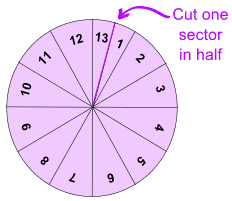
Rearrange the 13 sectors like this:

Which resembles a rectangle:

What are the (approximate) height and width of the rectangle?
The height is the circle's radius: just look at sectors 1 and 13 above. When they were in the circle they were "radius" high.
The width (actually one "bumpy" edge) is half of the curved parts along the circle's edge ... in other words it is about half the circumference of the circle.
We know that:
Circumference = 2 × π × radius
And so the width is about:
Half the Circumference = π × radius
And so we have (approximately):

Now we just multply the width by the height to find the area of the rectangle:
Area = (π × radius) × (radius)
= π × radius2
Note: The rectangle and the "bumpy edged shape" made by the sectors are not an exact match.
But we could get a better result if we divided the circle into 25 sectors (23 with an angle of 15° and 2 with an angle of 7.5°).
And the more we divided the circle up, the closer we would get to being exactly right.
Conclusion
Area of Circle = π r2
Annulus
|

|
|
An annulus is a flat shape like a ring.
Its edges are two circles that have the same center.
|
Area
Because it is a circle with a circular hole, you can calculate the area by subtracting the area of the "hole" from the big circle's area:

Area = πR2 - πr2
= π( R2 - r2 )

Example: a steel pipe has an outside diameter (OD) of 100mm and an inside diameter (ID) of 80mm, what is the area of the cross section?
Convert diameter to radius for both outside and inside circles:
- R = 100 mm / 2 = 50 mm
- r = 80 mm / 2 = 40 mm
Now calculate area:
Area = π( R2 - r2 )
Area = 3.14159... × ( 502 - 402 )
Area = 3.14159... × ( 2500 - 1600 )
Area = 3.14159... × 900
Area = 2827 mm2 (to nearest mm2)
Circle Theorems
Some interesting things about angles and circles.
Inscribed Angle
First off, a definition:
Inscribed Angle: an angle made from points sitting on the circle's circumference.
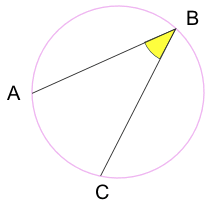
A and C are "end points"
B is the "apex point"
Inscribed Angle Theorems
An inscibed angle a° is half of the central angle 2a°

(Called the Angle at the Center Theorem)
And (keeping the endpoints fixed) ...
... the angle a° is always the same, no matter where it is on the circumference:
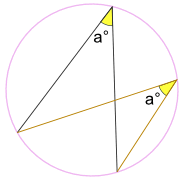
Angle a° is the same.
(Called the Angles Subtended by Same Arc Theorem)
Example: What is the size of Angle POQ? (O is circle's center)
|

|
Angle POQ = 2 × Angle PRQ = 2 × 62° = 124°
|
Example: What is the size of Angle CBX?
|
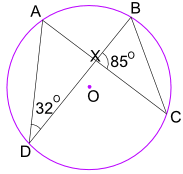
|
Angle ADB = 32° equals Angle ACB.
And Angle ACB equals Angle XCB.
So in triangle BXC we know Angle BXC = 85°, and Angle XCB = 32°
Now use angles of a triangle add to 180° :
Angle CBX + Angle BXC + Angle XCB = 180°
Angle CBX + 85° + 32° = 180°
Angle CBX = 63°
|
Angle in a Semicircle
An angle inscribed in a semicircle is always a right angle:

(The end points are either end of a circle's diameter,
the apex point can be anywhere on the circumference.)
|
Why? Because:
The inscibed angle 90° is half of the central angle 180°
(Using "Angle at the Center Theorem" above)
|

|
|
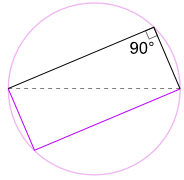
|
|
Another Good Reason Why It Works
We could also rotate the shape around 180° to make a rectangle!
It is a rectangle, because all sides are parallel, and both diagonals are equal.
And so its internal angles are all right angles (90°).
|

|

So there we go! No matter where that angle is
on the circumference, it is always 90°
Example: What is the size of Angle BAC?
|

|
The Angle in the Semicircle Theorem tells us that Angle ACB = 90°
Now use angles of a triangle add to 180° to find Angle BAC:
Angle BAC + 55° + 90° = 180°
Angle BAC = 35°
|
Cyclic Quadrilateral
|
A "Cyclic" Quadrilateral has every vertex on a circle's circumference:
|
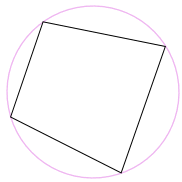
|
|
A Cyclic Quadrilateral's opposite angles add to 180°:
- a + c = 180°
- b + d = 180°
|
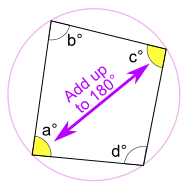
|
Example: What is the size of Angle WXY?
|
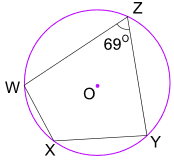
|
Opposite angles of a cyclic quadrilateral add to 180°
Angle WZY + Angle WXY = 180°
69° + Angle WXY = 180°
Angle WXY = 111°
|
|
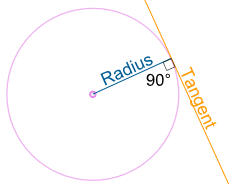
|
Tangent Angle
A tangent is a line that just touches a circle at one point.
It always forms a right angle with the circle's radius.
|
|


